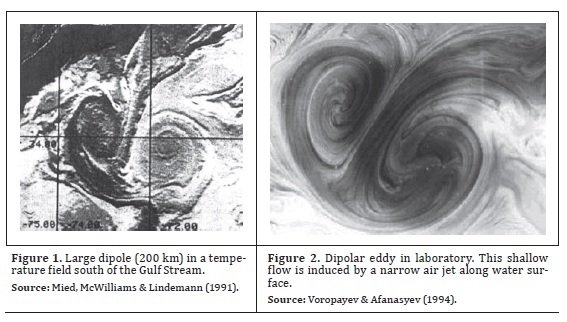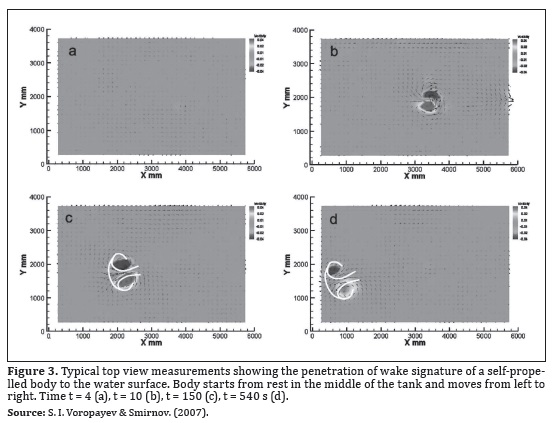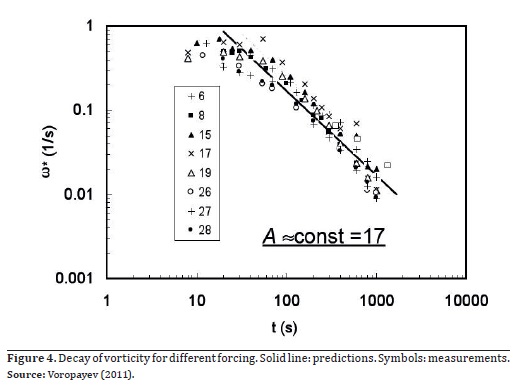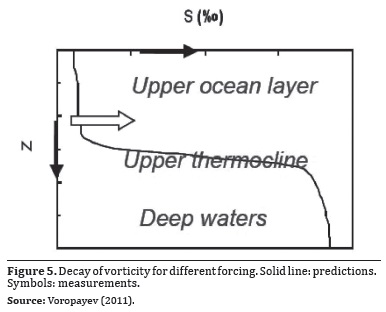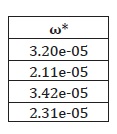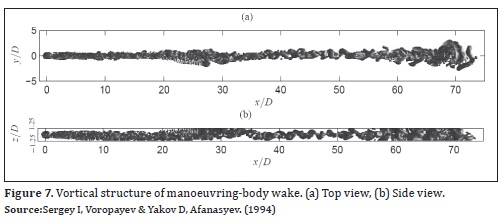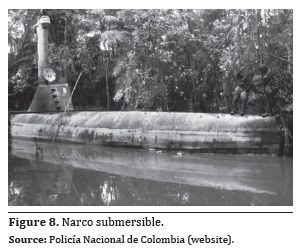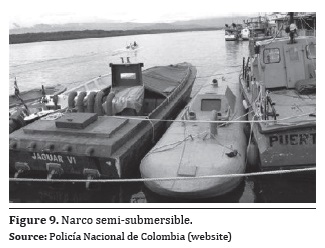Services on Demand
Journal
Article
Indicators
-
 Cited by SciELO
Cited by SciELO -
 Access statistics
Access statistics
Related links
-
 Cited by Google
Cited by Google -
 Similars in
SciELO
Similars in
SciELO -
 Similars in Google
Similars in Google
Share
Revista Científica General José María Córdova
Print version ISSN 1900-6586
Rev. Cient. Gen. José María Córdova vol.11 no.11 Bogotá Jan./June 2013
Thermal Wake on Narco-Semi-Submergibles and other Vortex Effects*
Estela térmica en narco-semi-sumergibles y otros efectos vórtice
Sillage Thermique des Narco-Semi-Submersibles et d'autres Effets tourbillonnaires
Esteira Térmica de Semi-Submergíveis Narco e outros Efeitos de Vórtice
Javier García Peláez a, Isabel Ainhoa Nieto Sevilla b
* Este trabajo es, principalmente, un compendio del estado del arte relativo a los trabajos de Voropayev y a análisis no publicados de los autores en el ámbito de sus trabajos en la Sección de Anteproyectos ('Preliminary Submarine Design Department'), Departamento de Ingeniería, del Astillero de Navantia en Cartagena, España. Esto significa que algunas de las indicaciones sobre el artículo (v. gr. la naturaleza de las amenazas) deben ser consideradas como opiniones del autor, siempre y cuando la investigación interna pertinente no esté disponible públicamente.
a. Arquitecto Naval, es actualmente el Jefe de la Sección de Anteproyectos ('Preliminary Submarine Design Department') del Astillero de Navantia en Cartagena, la Autoridad Acústica del Proyecto Submarino S-80 para la Armada Española y principal especialista en control no acústico (furtividad). Armada Española, Cartagena, España. Comentarios a: jgpelaez@navantia.es
b. Ingeniera de Telecomunicación con MSc ('Master of Science'), es actualmente la principal especialista en control acústico, en el Departamento de Ingeniería del Astillero de Navantia en Cartagena, del Proyecto Submarino S-80 para la Armada Española. Armada Española, Cartagena, España. Comentarios a: technopro.inieto@navantia.es
Recibido: 12 de Marzo de 2013. • Aceptado: 18 de abril de 2013.
Abstract
A decade and a half of experimental and theoretical studies on dynamics and interactions of vortex structures in stratified fluids have been developed by Sergey I. Voropayev (PhD) and other collaborators in order to provide a public consistent set of mathematical and numerical models of vortex structure interactions, which have high civil and military interest. For submarine design, this effort provides a rational scope to design its stealth against the wake-homing torpedoes. For frontier or coastguard forces, it provides some key questions to thermal wake semi-submersibles searching, which could be improved if some physics are detailed.
Keywords. Vortex structures, stratified fluids, wake-homing torpedoes, thermal wake, narco-submersibles.
Resumen
Una década y media de estudios experimentales y teóricos sobre la dinámica y las interacciones de las estructuras de vórtices en fluidos estratificados han sido desarrollados por Sergey I. Voropayev (PhD) y otros colaboradores, con el fin de proporcionar un conjunto consistente y publicable de modelos matemáticos y numéricos sobre las interacciones de las estructuras vórtice, las cuales tienen gran interés civil y militar. Para el diseño de submarinos, esta iniciativa proporciona un marco racional para el diseño de su furtividad en contra de los torpedos tipo wake-homing. Para las fuerzas fronterizas o guarda-costas, ofrece algunas preguntas clave relativas a cómo desarrollar la búsqueda de estelas térmicas semisumergibles, la cual podría mejorarse si se detallan ciertas nociones físicas.
Palabras clave. Estructuras vórtice, fluidos estratificados, torpedos wake-homing, estela térmica, narco-sumergibles.
Résumé
Une décennie et demie détudes expérimentales et théoriques sur la dynamique et les interactions des structures tourbillonnaires dans les fluides stratifiés ont été développés par Sergey I. Voropayev (PhD) et d'autres collaborateurs afin de proportionner un conjoint consistant et publiable de modèles mathématiques et numériques sur les interactions des structures tourbillonnaires dont ils ont un grand intérêt dans les domaines civil et militaire. Dans le design des sous-marins, cette initiative proportionne un cadre rationnel pour le design de furtivité contre les torpilles wakehoming. Pour les forces frontalières ou les garde-côtes, elle offre certaines questions clés relatives de comment développer la recherche des stèles thermiques semi-submersibles dont elle peut être améliorée si on détaille des certaines notions physiques.
Mots-clés. Structures tourbillonnaires, fluides stratifiés, torpilles wake-homing, stèle thermique, narco submersible.
Resumo
Sergey I. Voropayev (PhD) e outros parceiros desenvolveram durante uma década e meia estudos experimentais e teóricos sobre a dinâmica e as interações de estruturas de vórtices em fluidos estratificados, com a finalidade de fornecer um conjunto publicável de modelos numéricos e matemáticos que consistem em interações de estruturas de vórtices, que têm um grande interesse civil e militar. Para o desenho de submarinos, esta iniciativa proporciona um âmbito racional para projetar uma ação furtiva contra torpedos wake-homing. Para as forças de fronteira ou da guarda costeira, oferece algumas questões-chave para rastrear a esteira térmica de semi-submergíveis, que podería ser melhorado com algumas noções físicas.
Palavras-chave. Estruturas de vórtices, fluidos estratificados, torpedos wake-homing, esteira térmica, narco-submergíveis.
Introduction
The aim of this paper is to try to approach the interest of military specialists in complex hydrodynamic phenomena which could represent threats and/or opportunities for their work.
In general terms, this research is based on “acoustics” which varies really slowly in time, as the stationary dynamics of the “propeller tonals”, where the acoustics of the stratified wake, in which we are interested, provokes singular patterns which are commanded by the non-Riemannian term of the sound wake equation, see Garcia de Andrade (Andrade, 2005). For this subject, the vorticity field has been simplified as the related Voropayev empirical invariant potential, see (Voropayev, 2007).
1. Thermal Wake on Narco-Semi-Submersibles and other Vortex Effects
In the classical wake analysis signature, the wake and waves characteristics generated by a towed (drag) element have been evaluated considering idealized environment with simple environmental geometries and stratifications.
But, hereafter, the sensors capability to detect self-propelled submerged bodies will be evaluated due to the fact that the changes in the environment, caused by internal waves and wakes generated by the passage of a submarine, are significantly different between towed wakes and self-propelled (with vorticity generated by a moving momentum source) wakes.
The understanding of this turbulent phenomenon improves the knowledge of the real signatures that could be measured by the new different methods which are being explored for non-acoustic detection, focusing on discerning the anomalies in the sea surface. Therefore, the conditions under which submerged momentum disturbances can penetrate upward and create detectable signatures on the water surface will be included in the present paper.
In many liquid systems the motion in one direction is suppressed. A typical example is a density stratified fluid where the vertical motion is suppressed by the buoyancy force and flows are, frequently, effectively horizontal, i.e., with large horizontal and relatively small vertical size. In a stratified fluid, the wake eddies collapse vertically and spread horizontally. Thus, their signature becomes two dimensional.
The wake eddies belong to a broad class of vortical flows generated in stratified fluids by concentrated (localized) forcing. The forcing source can act continuously or impulsively, as explained below, generating a variety of flows.
More specifically, when a body is towed, it imparts momentum (equal to the drag of the body) to the wake. In contrast, for a constant speed self-propelled body, the drag is cancelled by the thrust, leading to a zero-momentum wake. In practice, a submerged vehicle leaves behind a finite momentum wake when it accelerates or changes direction and a momentumless wake only when it moves at constant speed. A manoeuvring-body wake is of interest because it can introduce dynamics that are absent from the constant-velocity case, especially when the wake is influenced by stable stratification.
Dipole vortices produced by the interaction of manoeuvring-body wakes with stable background density stratification are very large, compared to the size of the body, and long-lived. Voropayev et al. (1999) estimate that a coherent kilometre-scale vortical structure that persists for the order of days can be observed behind a typical submarine manoeuvre in the ocean (in any depth if stratification is present, at periscope depth, secure depth or maximum depth).
In the previous figures, the 2D structure of the wake vorticity can be observed.
In relation to this fact, when momentum is imparted into a flow, it leads to an isolated region which possesses a high concentration of vorticity and a non-zero net linear momentum, often referred to as a turbulent blob.
In an unbounded homogeneous fluid, the turbulent blob is fully three-dimensional. While the blob is propagating away from its origin, its vertical and horizontal sizes increase due to the entrainment process of the surrounding fluid and the blob eventually transforms into a toroidal vortical structure.
In contrast, when the vertical growth of the blob is confined (e.g. by buoyancy force), only its horizontal size can expand due to the lateral entrainment, which leads to a quasi-planar counter rotating vortex (see Figures 1 and 2).
The formation and evolution of vortical dipoles have been widely studied in a linearly stratified fluid, above all by Voropayev et al. The content of this paper, about the study of the conditions under which submerged momentum disturbances can create detectable signatures on the water surface, is based mainly on their work.
Voropayev research concluded that, in a turbulent regime, after the formation of the turbulent wake, the flow thickness does not change with time; conservation of flow momentum leads to flow similarity at intermediate times (see Figure 3).
It can be observed in the previous figure that, with the motion being time-dependent, the vorticity pattern - once it has reached the surface - does not change with time.
The most important governing parameters are the forcing, the buoyancy frequency (N) and the time; and the main flow characteristic, in terms of Turbulent Wake Signature, is the parameter ω*, the typical vorticity.
For this last parameter, after experimentation, the following decay law has been concluded:
ω* = A / t
Taking into account the results of the works of Voropayev, the decay of vorticity has turned out to be non-dependent on the forcing intensity (and non-dependent on the size of the submarine, its advance speed or the violence of the particular manoeuvre).
To summarise this theoretical introduction, it is again remarked that a concentrated source of momentum, located in a large volume of fluid, leads to an isolated turbulent flow region with a high concentration of vorticity and nonzero net linear momentum.
In a homogeneous fluid, being devoid of buoyancy effects, this turbulent blob is nearly spherical with predominantly azimuthal vorticity distribution. With time, the blob propagates away from the origin while increasing the size due to entrainment of surrounding fluid and decreasing the velocity of propagation to conserve momentum.
In a density stratified fluid, where vertical motions are suppressed by buoyancy forces, the initial near-spherical blob with horizontal momentum rapidly collapses in the vertical direction. Thereafter, the vertical growth of the blob is inhibited by the stratification, but its horizontal size continues to increase with time due to lateral entrainment, and the eddy as a whole propagates from the origin with decreasing velocity. These dipolar eddies are usually very stable, can interact with each other or solid boundaries and survive in a field of typical oceanic background shear.
In practice, it is not very important how the momentum disturbance is generated and locally imparted on the fluid or how vertical motion is suppressed, given that in all cases the resulting flow asymptotically transforms into a large dipolar eddy oblivious of its generation mechanism.
Those large momentum vortex structures, generated in a stratified fluid during the acceleration of self-propelled bodies, have been demonstrated by research to be much larger than those produced during the steady motion case.
For example, estimates have shown that when an oceanic submerged vehicle changes its velocity by 10% or its direction by 5 degrees, large eddies of size 1-2 km with a decay time of several days can be anticipated. Although such eddies can survive in the field of oceanic background shear, they are usually confined to the stratified layers without penetrating the surface of the water.
The upper ocean is nominally homogeneous in density and can be considered as a shallow layer (typical depth 50-100 m) that rests aloft denser (more salty/cold) water:
Under certain conditions, momentum disturbances produced in the upper ocean layer by a submerged submarine may penetrate through the upper layer and produce detectable signatures at the water surface.
Voropayev observations suggest the following mechanism for eddy formation and its surface penetration: When the model accelerates in a homogeneous upper layer, localized impulsive turbulent disturbance is generated, which spreads in the vertical direction via entrainment but is confined by the upper-layer boundaries.
With time, the aspect ratio of the disturbance (vertical to horizontal dimensions) becomes small and the flow becomes approximately horizontal. If the flow momentum is sufficiently high, a large dipolar eddy can be formed in the upper layer. This eddy spreads over the entire upper layer depth, leading to recognizable dipole signatures at the water surface (see example in Figure 3). This dipole is similar to that in stratified fluids with one essential difference: the thickness of the dipole depends on the intensity of stratification, whereas the depth of the upper homogeneous layer limits the dipole thickness in the former case.
2. Turbulent Wake Signature in Surface
Wake-homing torpedoes are guided by sensors that detect the presence of persistent turbulence of any surface ship's wake.
The torpedo winds from one side to another within the cone of the wake and follows it to the ship's stern before detonation. It is relatively simple for the seeker to determine the boundaries of the wake, which extend many lengths behind the target.
As a countermeasure, the wake generation (relying on torpedo seduction) is ineffective since a wake is difficult to simulate due to the fact that its size (width and detectable distance) is linear with the ship displacement elevated to 0.15 - 0.18 and the “small momentum generators” launched as countermeasures turn out to be insufficient to discard targets.
Taking into account this discrimination regarding the displacement carried out by the wake homing torpedoes, in 1968, the first soviet 53-65 torpedo version became operational to engage US Navy super-carriers.
Currently, not only Russian torpedoes but torpedoes such as the French F-17 Mod. 2, the German DM2A4 and the Italian Black Shark have carry additional wake-homing features to help and complement principal sensors.
Better acoustic and non-acoustic performances for sensors which detect bubbling, swirling of the propeller rotation and broadband turbulence for a developed wake have made other homing strategies possible, like the “wake-nibbling”. With wake-nibbling strategy, the seeker detects and follows the boundaries of the wake, so the torpedo results in being more efficient because it expends less time and energy re-crossing the wake to delimitate it.
Figure 6 is an example of a surface ship wake signature (in terms of thermal contrast in the sea surface) behind a body of 70 m length, of an “effective” wake length of 50 times the ship length.
In this wake, its two-dimensional (planar) eddy structures are clearly presented. This two dimensional pattern is physically possible (and highly stable) due to the typical temperature gradient (so, density gradient) with the depth, strong gradient for the first 10 - 20 metres (e.g., diurnal thermocline, depth 1-10 m).
The used physic parameter to classify these gradients is the buoyancy frequency (or Brunt- Väisälä frequency), N, defined as the angular frequency at which a vertically displaced parcel will oscillate within a statically stable environment (in our case, in the presence of a background stratification in which the density changes in the vertical direction, see Figure 5):
Following the works of Voropayev and collaborators from the Institute of Oceanology, Russian Academy of Sciences and Arizona State and Notre Dame Universities, as explained in the preceding section, this parameter appears as the main cause of the effective (high contrast) wake development.
In fact, the bigger N is, the more reduced the thickness of the layer is, concentrating the momentum of the ship in a minor but longer wake with bigger two-dimensional eddies. It is relevant to indicate that the two-dimensional nature of the wake is essential to be persistent, so wake-homing torpedoes are typically devoted to surface ships because, in the floating condition, the necessary homogeneous upper layer conditions cannot be avoided.
A typical SSK - since it can snort or obtain communications, ESM or photographic intelligence - is a likely target for a wake-homing torpedo for the first stage of its passive-silent seeking, due to the fact that a wake as long as 10 km can be generated on a “summer” day (N = 0.01) during a straight or zig-zag manoeuvre at a 10 m depth wake turbulent layer.
Therefore, as a countermeasure, the SSK could embark a specific bubble decoy launcher to provide, in snorkel condition, an initial seduction turbulent pattern for torpedoes at the same time immersion is provided and the long pattern wake is broken.
The part of the wake associated to the propeller rotation collapses really quickly, with t = 1/(7N), where t is time in seconds. So, for instance, with an advance speed of 5 m/s and N = 0.02, the near wake (local velocity deficit) is not longer than ½ submarine length.
However, the swirl from the propulsion system can remain with a more persistent presence. In any SSK propeller design, a careful cavitation design and towing test validation have to be carried out and the results indicate no presence of relevant swirling for the operational speeds. See inception cavitation speed - depth limits for hub and tip blade swirling detachment.
Once in immersion condition, similar contour conditions are necessary to obtain wakes and momentum (dipolar) eddies generated in stratified fluids by concentrated (localized) forcing, the propulsion of the submarine.
Since the submarine, as the forcing source, can act continuously or impulsively, the created wake can be more or less relevant as signature. As Voropayev works claim, the stationary flight of a submarine is not really relevant as signature under stratified fluid immersion, since those large momentum vortex structures, generated in a stratified fluid during the acceleration of self-propelled bodies, have been demonstrated by research to be much larger than those produced during the steady motion case.
The decay law for the relevant vorticity created during the submarine manoeuvres can be seen in the Figure 4, the seemingly paradoxical dimensional prediction which indicates that the intensity of the related vorticity for the complete wake is independent of the forcing intensity (so, is the same for a big or small submarine, only the size of wake changes) and depends only on time.
On the contrary, the vorticity threshold for the creation of broadband turbulent patterns of the oceans is very stable, but very reduced with respect to the values given in the decay law. As an example, see the following table with the threshold vorticity values for four upper layer buoys of North Atlantic Ocean:
With these values, it is clear, following the vorticity decay law, that the eddies of (any kind of) submarine wake will survive and remain detectable for days.
Finally, from Voropayev works it is easy to obtain, for one particular displacement submarine if dynamics of manoeuvring are provided (hydrodynamic derivate model), the eddy size, the eddy distance from the propeller, the eddy thickness (which is related with N as in surface sailing) and the eddy propagation velocity for a particular manoeuvre.
See the example given in Figure 7 where the top and side view from a vortical structure of a manoeuvring-body wake is presented, extracted from the works of Voropayev.
Obviously, taking into account the practical independence of this kind of immersion wake from the submarine design, the addressed countermeasures against this signature in operation are listed below:
- Not to remain in “calm” waters at the same depth for too much time (vertical zig-zag is not relevant in strong stratified waters).
- To manoeuvre as softly as possible on circles of evolution or changes of heading.
- Not to manoeuvre on a 2D repeated pattern (as horizontal zig-zag) but in a 3D path (always combining pitching and heading).
3. Tactical use of thermal wake on detection of semi-submersibles
A real submersible as shown in Figure 8 is, very probably, a rudimentary version of an asymmetric warfare current design of the Chinese Army, able to maintain, with batteries, 3 knots / 24 h @ 30 m secure depth against the state-of-the-art aerial or satellite ASW positive detection.
In this case, there is no present risk of long thermal wake on the “waited” control areas of the Coastguards or Air Forces.
So, classical anti-submarine acoustic detection (not precluding the use of new non-acoustic approaches) based on submarines (as the new Colombian U-206 pair of SSK's with the current modernization and specific improved electronics) could be used: net of sono-buoys to be deployed by the police, the army or naval helicopters or others (AUVs, RHIB + combat swimmers with portable hydrophones, etc.).
Above, we can see the most common used vehicles but not real submersibles. They are indigenous designs of semi-submersibles (a concept similar to s.XIX monitors), which are only able to have 100% cruising time in snorkelling condition (with very low radar cross section profile of the snorkel tubes).
So, in this case, other non-acoustic signature searchers could be most relevant as chemical sniffers or long range laser spectrography (looking for products of diesel combustion transported by wind forces). Taking into account the spread of the exhaust products, it would be possible to calculate the origin if sufficiently good 2D meteorology charts are available in real time.
Conclusión
Finally, considering the theme of this paper, the thermal wake of semi-submersibles could be the first point to focus on, since the initial detection of these platforms is supposed to entangle the target with infrared searching from helicopters, planes or satellites, especially, for warm waters like North-Peruvian, Equatorial and Colombian waters or, more dramatically, Caribbean waters.
In conclusion, since the thermal wake, if any, is of the order of 1 km (for this kind of boat), one huge initial searching square could be deployed for a first contact, avoiding the difficulties of detection caused by the very low radar cross section of this type of target.
Bibliography
As primary references for the related physics, the following ones are recommended:
1. L.C. García de Andrade. (2005, 327-329). On the necessity of non-Riemannian acoustic spacetime in fluids with vorticity. Physics Letters A 346. [ Links ]
2. S. I. Voropayev, H. J. S. Fernando, S. A. Smirnov & R. Morrison. (2007). On surface signatures generated by submerged momentum sources. Physics of Fluids 19, 076603. [ Links ]
3. S. I. Voropayev, I.A. Filippov, Y.D. Afanasyev, G.I. Barenblatt, H.J.S. Fernando, S.N. Smirnov, B. McEachern, R. Morrison & C. Nath (2011, September, 7-9). Jets, wakes and momentum eddies in stratified fluids and their surface signatures: Laboratory experiments, theoretical modeling and possible applications. Conference on UKTC 2011, Imperial College, London. 2011. [ Links ]
4. S. I. Voropayev, S. A. Smirnov, I. A. Filippov and D. L. Boyer (2000). Large Eddies and Vortex Streets Behind Moving Jets in a Stratified Fluid. [ Links ]
5. Sergey I. Voropayev and Yakov D. Afanasyev (1994). Vortex Structures in a Stratified Fluid: Order from Chaos. Chapman & Hall. [ Links ]
6. Watchapon Rojanaratanangkule, T. Glyn Thomas and Gary N. Coleman. Numerical Study Of Turbulent Manoeuvring-Body Wakes: Interaction With A Free Surface. School of Engineering Sciences. University of Southampton. [ Links ]













